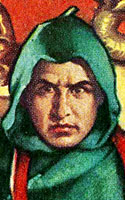
Few pulp heroes were able during the classic period to make the transition from the pulp magazines to other medium such as movies/movie serials, radio, comics books, or comic strips. And even fewer were able to appear in multiple media.
One of the few who did was The Green Lama. Unusual, because he was published by a small company, and more unusual, all his non-pulp appearances were under the aegis of his creator, who was somehow able to maintain ownership of the character. He appeared in pulps, comics books and radio. There was apparently talk about doing a TV show!
The Green Lama appeared during what pulp historian Will Murray calls the “third wave” of pulp heroes. More colorful than heroes in the previous waves, the “third wave” pulp heroes would be a better able to compete against the new comic book heroes.
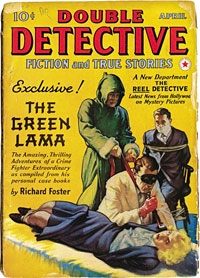 The Green Lama was created by Kendell Foster Crossen for Munsey and was cover featured in their Double Detective pulp magazine in the early 1940s for 14 issues. He was intentionally inspired by The Shadow (the plans were to call him the “Gray Lama,” but it was decided green would be more colorful, so the change — hey, the same thing happened to the Hulk), but with very clear Buddhist influences. And, it seems that they really tried to get things right.
The Green Lama was created by Kendell Foster Crossen for Munsey and was cover featured in their Double Detective pulp magazine in the early 1940s for 14 issues. He was intentionally inspired by The Shadow (the plans were to call him the “Gray Lama,” but it was decided green would be more colorful, so the change — hey, the same thing happened to the Hulk), but with very clear Buddhist influences. And, it seems that they really tried to get things right.
Altus Press reprinted the complete series in three volumes. The first volume reprints the first five stories: “The Case of the Crimson Hand,” “The Case of the Croesus of Murder,” “The Case of Babies for Sale,” “The Case of the Wave of Death,” and “The Case of the Man Who Wasn’t There.” The volume contains an introduction by Will Murray, giving a background on the creation of the character and his use in other media. Also includes a write-up on the character by Crossen.
In the first story, we are introduced to the Green Lama, who is really Buddhist Jethro Dumont, who was made a lama in Tibet. He always disguises himself as the Rev. Dr. Pali, a Buddhist priest, hence no one connects Dumont with the Green Lama. And like The Shadow, he has several aides that help him battle the forces of evil in the western world. We met the first aide in the first story, and he starts gathering new aides from that point. In the fifth story, two of his aides marry, and more or less leave the series (kind of unusual), but two characters who are introduced in that story step up to take their place. Another individual is the mysterious Magga, who helps the Lama, but whose real identity is never revealed to us or the Lama. Crossen didn’t even bother to come up with a background for her, just wanting her to be mysterious.
It is interesting how the stories are interconnected. The first story is set in New York, the second in Florida (the town of Arabia seems loosely based on the real town of Opa-locka), the third and fourth are set in California, while the fifth is set on a ship taking the Green Lama from California back to New York. The stories are heavily footnoted, sometimes giving explanations of the Buddhist stuff, sometimes referring back to previous stories and the like.
In the second volume from Altus Press, we get the next five stories: “The Case of the Death’s-Head Face,” “The Case of the Clown Who Laughed,” “The Case of the Invisible Enemy,” “The Case of the Mad Magi,” and “The Case of the Vanishing Ships.” In addition to the stories, we have an intro that focuses on the comic book versions, with new info on Spark Comics’ series. Also included is a brief bio of the artist for these stories.
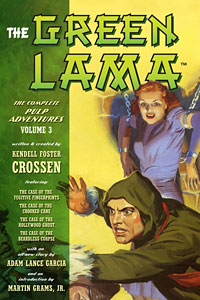 The first story in this volume continues some of the storylines from the previous volume. We had the marriage of two of the Green Lama’s assistants (Gary and Evangl), who largely leave the series, to be replaced by Jean Farrel and Ken Clayton who also appeared in the previous story. As noted, that’s something unusual, as secondary characters usually don’t do this in the pulps. Also, the villains of this story were hinted at in the previous one.
The first story in this volume continues some of the storylines from the previous volume. We had the marriage of two of the Green Lama’s assistants (Gary and Evangl), who largely leave the series, to be replaced by Jean Farrel and Ken Clayton who also appeared in the previous story. As noted, that’s something unusual, as secondary characters usually don’t do this in the pulps. Also, the villains of this story were hinted at in the previous one.
The third story is interesting as it deals with Fifth Columnists in America who are allied with Hitler. And this is before the U.S. entered WWII, but at the time there were people who were concerned about the fascists in Europe and warned against them.
In the third and final volume from Altus Press, we get the final four stories: “The Case of the Fugitive Fingerprints,” “The Case of the Crooked Cane,” “The Case of the Hollywood Ghost,” and “The Case of the Beardless Corpse.” Also included is a new story by Adam Lance Garcia with artwork by Mike Fyles: “The Case of the Final Column,” which bridges over to the new Green Lama stories that have been appeared from Airship 27, mainly by Garcia. As a bonus in this book, we see the 1945 paperback reprint of this story. This volume contains an introduction by radio historian Martin Grams Jr., on the Green Lama radio series, and Crossen’s involvement with radio dramas.
“The Case of the Fugitive Fingerprints” is an interesting murder mystery, dealing with blackmail among Hollywood-types in New York. “The Case of the Crooked Cane” has the Green Lama and associates return to Cleveland for the third time. Here they deal with a drug smuggling operation that is making use of refugees from Europe. One of his associates has now joined the Army, and he is replaced by a magician they had previously met in Cleveland. He will appear again in the following stories.
“The Case of the Hollywood Ghost” has the Green Lama and associates return to Hollywood. The story deals with a mysterious murder that is tied in with the movie studio encountered the last time the Green Lama was in Hollywood. And “The Case of the Beardless Corpse” is set in New York. Hints are made to the ongoing war.
Comic books
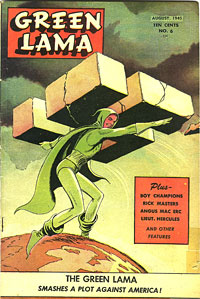 As noted, the Green Lama appeared in comic books. First as a long-running strip in Prize Comics #7-34, written by Crossen, but a version that’s a little different from the pulps. It appeared while the Green Lama pulps were appearing (1940-43). Toward the end of WWII, Crossen forms Spark Comics, and one of their titles was The Green Lama which lasted eight issues. Here, another, more different version of the Green Lama is presented, with artwork by the great Mac Raboy. He uses his phrase “Om! Ma-ni pad-me Hum!” — similar to how Captain Marvel uses “Shazam!” — to transform into the Green Lama, who can fly! Dark Horse Comics has reprinted the complete eight-issue series in two hardcover archive editions.
As noted, the Green Lama appeared in comic books. First as a long-running strip in Prize Comics #7-34, written by Crossen, but a version that’s a little different from the pulps. It appeared while the Green Lama pulps were appearing (1940-43). Toward the end of WWII, Crossen forms Spark Comics, and one of their titles was The Green Lama which lasted eight issues. Here, another, more different version of the Green Lama is presented, with artwork by the great Mac Raboy. He uses his phrase “Om! Ma-ni pad-me Hum!” — similar to how Captain Marvel uses “Shazam!” — to transform into the Green Lama, who can fly! Dark Horse Comics has reprinted the complete eight-issue series in two hardcover archive editions.
There has been some recent re-use of the comic book Green Lama by a few publishers, claiming the comic book copyright has expired. AC Comics published a short unfinished mini-series based on the Spark version. And Dynamic has used him heavily in their “Project Superhero.”
Radio show
As noted, a short-lived radio show of the Green Lama was produced, also written by Crossen. It ran for 12 episodes in summer 1949. Supposedly this sparked some interest in a possible TV show, but nothing came of it.
New Pulp
Airship 27 has been publishing new stories of the Green Lama. So far a collection of short stories and a novel by Adam Garcia, with a second novel from Garcia promised. I can’t wait. Garcia has tried to combine the pulp and comic book versions and I think he’s done a good job.
Check out the Green Lama. A very interesting, if short-lived character.

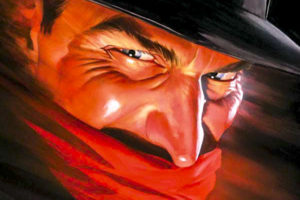
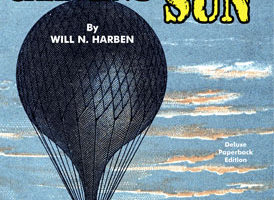
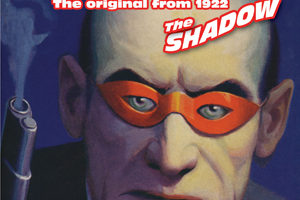
All I can say is stay tuned… There’s a LOT of new work coming, but from a new publisher…
With copious amounts of new Green Lama artwork!
Yeah!! Look forward to it. Been awaiting in for a long time.